Last Updated on February 23, 2024 by JigsawPuzzleGuru
Table of Contents
Exploring Varieties for Mental Challenge
Puzzle games offer a unique form of entertainment that challenges the mind and sharpens cognitive skills. Several types of puzzle games exist, each providing a different kind of mental workout.. Players might find themselves rearranging blocks, deciphering complex patterns, or solving riddles—all underpinning the fundamental appeal of puzzle games, which lies in the joy of problem-solving and the satisfaction of finding a solution.

Among the many types of puzzle games, some focus heavily on logic and strategic planning, such as Sudoku and chess puzzles, where each move requires careful consideration and foresight. Others, like jigsaw puzzles and match-three games, rely on spatial reasoning and pattern recognition, as players work to fit pieces together or create alignments of similar shapes or colors.
Additionally, adventure and escape room puzzles take players on a narrative journey, often integrating story elements that require players to unlock secrets or decipher codes to progress. These immersive experiences combine elements of various puzzle types to create a rich, engaging gameplay that not only entertains but also stimulates the mind.
Jigsaw Puzzles
Jigsaw puzzles are a form of tile puzzle where an image is segmented into interlocking pieces. Each piece is unique, with its own shape that fits into a corresponding space to complete the overall design. These puzzles come in a range of complexities, from simple designs for children to intricate and challenging images for adults.
Popularity: Jigsaw puzzles have been widely popular since their inception in the 18th century. They serve not only as entertainment but also as educational tools, helping to improve cognitive skills such as:
- Problem-solving
- Memory
- Visual-spatial reasoning
Materials and Sizes:
| Material | Description |
|---|---|
| Cardboard | Common for mid-level puzzles, affordable and light. |
| Wood | Higher-end puzzles, durable and offers a premium experience. |
| Plastic | Often used for 3D and long-lasting puzzles. |
Jigsaw puzzles can range from a few pieces to thousands, accommodating different skill levels and attention spans.
Variants:
- Traditional Puzzles: Standard 2D puzzles with flat pieces that form a picture.
- 3D Puzzles: Create three-dimensional objects or scenes.
- Family Puzzles: Feature sections with different sized pieces for various skill levels.
Digital Jigsaw Puzzles: With the advent of technology, digital versions have become available on computers and mobile devices. This format allows for features like zooming, sorting trays, and a multitude of images without the physical storage requirements.
Jigsaw puzzles continue to be a beloved hobby for all ages, offering a relaxing yet mentally stimulating challenge.
Logic Puzzles
Logic puzzles are a category of puzzles that require deductive reasoning and pattern recognition to solve. They come in various forms, challenging different aspects of logical thinking.
Sudoku
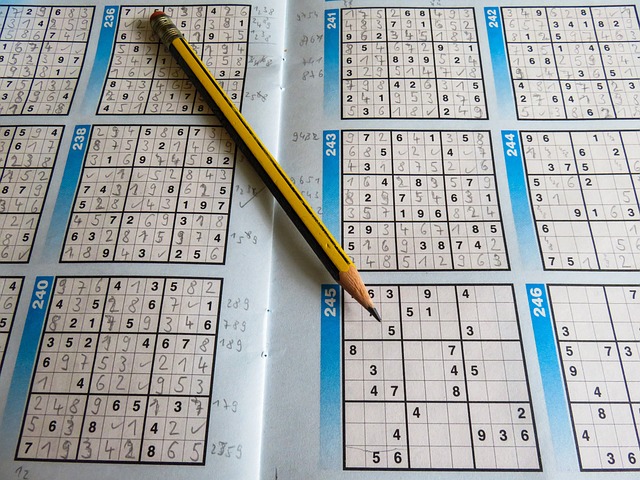
Sudoku is a number-placement puzzle that presents the player with a 9×9 grid, partially filled with numbers. The goal is to fill the grid so that each column, each row, and each of the nine 3×3 subgrids contain all of the digits from 1 to 9. The puzzle relies on logic to determine the placement of numbers, ensuring no repetitions.
Nonograms
Nonograms, also known as Picross or Griddlers, are picture logic puzzles in which cells in a grid must be colored or left blank according to numbers at the side of the grid. The numbers indicate the number of consecutive colored cells in each row or column. Solving a Nonogram leads to a hidden picture being revealed.
Logical Deduction
Logical Deduction puzzles are a broad subset of logic puzzles that include various types, from riddles requiring the solver to deduce relationships or patterns, to complex problems involving strategic planning. One popular example is the “Einstein’s Puzzle,” also known as the “Zebra Puzzle,” where the player must use provided clues to deduce the correct associations between different properties.
Word Puzzles
Word puzzles are an engaging way for individuals to challenge their vocabulary and their ability to recognize patterns in letters and words. These puzzles come in various formats, each offering a distinct type of problem-solving experience.
Crosswords
Crosswords feature a grid of white and black squares where the player fills in the white squares with letters by solving clues that correspond to numbered rows and columns. For example:
- 3 Across: A place for coins (4 letters)
- Answer: Bank
Players enhance their vocabulary and knowledge across numerous topics as they decipher each clue to complete the grid.
Word Search
Word search puzzles consist of a grid filled with letters where players need to find and mark words hidden in straight lines, either horizontally, vertically, or diagonally. Each game usually follows a theme, and words can intersect or overlap, creating a strategic challenge. Features of a word search might include:
- Grid size: 10×10
- Theme: Ocean
- Words to find: Shark, Coral, Tide
The objective is to locate all the words related to the theme hidden within the grid.
Letter Arrangement
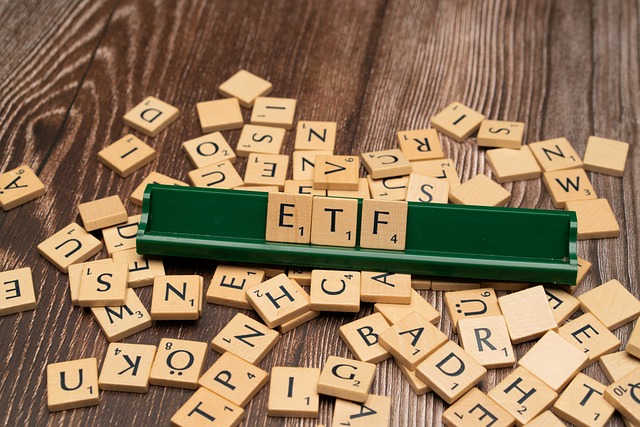
Letter arrangement puzzles require players to manipulate letters to form words. There are different varieties; some popular ones include:
- Anagrams: Players rearrange letters of a given word to create new words. For instance, the anagram of “LISTEN” is “SILENT”.
- Scrabble: This well-known board game has players scoring points by creating words on a grid-like board with lettered tiles, maximizing the use of limited resources and strategically using double or triple word and letter score spaces.
Identifying the longest word or the highest scoring word using a specific set of letters is key to excelling at these puzzles.
Number Puzzles
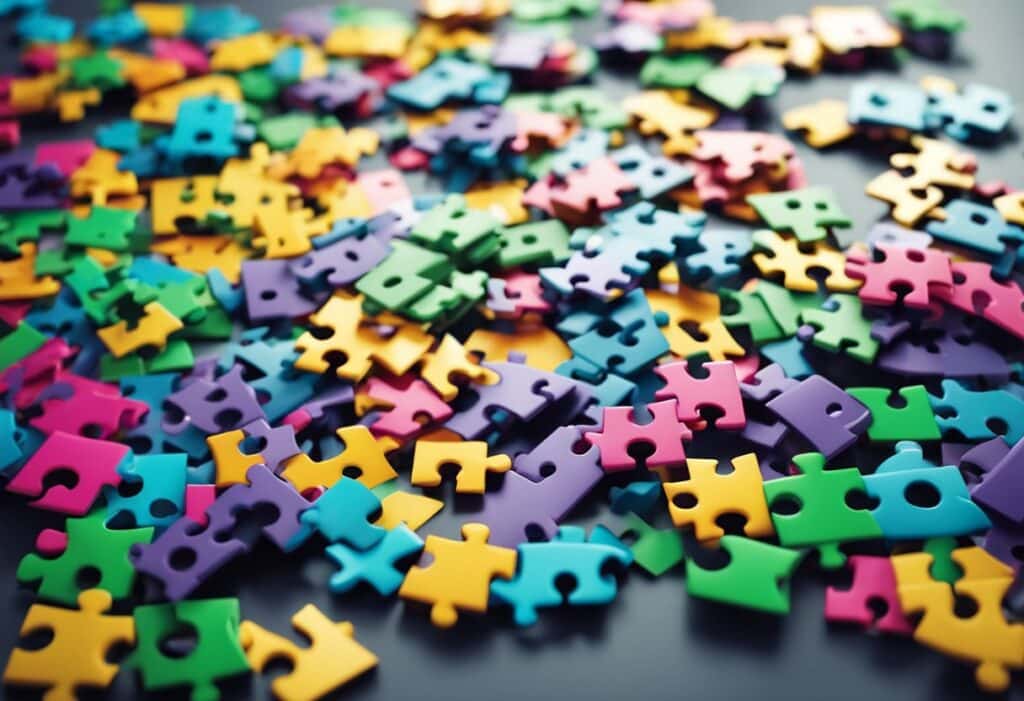
Number puzzles are games centered around numerical challenges, requiring logical thinking and often mathematical operations to solve. They can vary deeply in complexity and form, from simple addition problems to intricate layouts with multiple operations.
Math Puzzles
Math puzzles involve direct application of mathematical concepts and operations. They can be as straightforward as basic arithmetic problems or as complicated as advanced calculus questions. They are designed to test a person’s understanding and proficiency in various mathematical areas.
KenKen
KenKen is a grid-based numerical puzzle with a layout similar to Sudoku. Each grid cell must be filled with digits—without repetition in any row or column—such that the digits in a heavily outlined group satisfy a specified arithmetic operation (addition, subtraction, multiplication, or division) and result in a target number.
Table Example for KenKen Puzzle Structure:
| 4* | 15+ | ||
|---|---|---|---|
| 15+ | 1- | ||
| 1- | |||
| 4* | 2÷ |
Rules:
- No repetition of digits in any row or column.
- Use arithmetic operations to reach target numbers in groups.
- Fill all cells with acceptable digits.
Magic Squares
A magic square is a square grid filled with distinct positive integers in such a way that the sum of the numbers in each row, column, and diagonal are the same. Magic squares have a rich history and are known for their appearance in various cultures and mathematics.
Example of a 3×3 Magic Square:
| 2 | 7 | 6 |
|---|---|---|
| 9 | 5 | 1 |
| 4 | 3 | 8 |
Magic Sum: In this case, each row, column, and diagonal adds up to 15.
Visual Puzzles
Visual puzzles challenge the player’s perception and attention to detail through various forms of visual stimuli.
Spot the Difference
In “Spot the Difference” games, players are presented with two near-identical images and must identify the subtle discrepancies between them. The differences can range in difficulty and are often cleverly concealed.
Typical features of “Spot the Difference” puzzles:
- Number of Differences: Usually 5 to 15 per set of images.
- Themes: Can vary from simple cartoon scenes to complex photographs.
Picture Puzzles
“Picture Puzzles” encompass a wide range of puzzle types where players must assemble or interpret an image. Jigsaw puzzles and rebus puzzles are two common forms, each requiring spatial reasoning and pattern recognition.
Common forms of “Picture Puzzles”:
- Jigsaw Puzzles: Pieces must be connected to form a complete image.
- Rebus Puzzles: Pictures and symbols represent words or phrases to decipher.
Optical Illusions
“Optical Illusions” are visual puzzles that manipulate perception through the use of color, light, and patterns. These illusions can trick the mind into seeing things that aren’t there or seeing them differently than they are.
Examples of “Optical Illusions”:
- Ambiguous Images: Images that can flip between two distinct objects or scenes.
- Motion Illusions: Still images that appear to move due to the cognitive effects of interacting colors and shapes.
Physical Puzzles
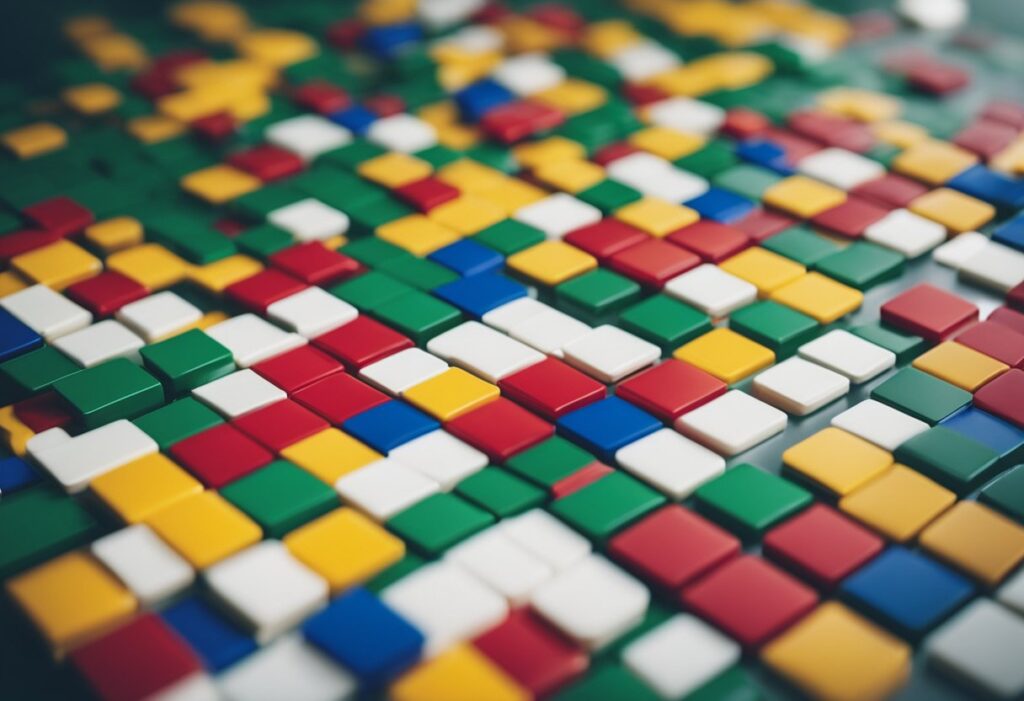
Physical puzzles challenge the mind through tangible manipulation. These puzzles require spatial reasoning, manual dexterity, and pattern recognition.
Rubik’s Cube
The Rubik’s Cube is a 3-D combination puzzle, invented in 1974 by Ernő Rubik. It consists of a cube with six faces, each face featuring nine squares. Each face’s color must be unison after the cube’s parts have been twisted in multiple directions. A standard Rubik’s Cube measures 5.7 centimeters on each side and features six distinct colors.

Lock Puzzles
Lock puzzles, also known as trick locks, aren’t typical locking mechanisms. They typically require a series of complex moves or understanding hidden mechanisms to be opened. These puzzles may appear as conventional locks but are crafted for puzzle-solving, often without a key as part of the challenge.
Tangrams
Tangrams are dissection puzzles consisting of seven flat pieces called tans, which are put together to form a square. The objective is to rearrange the tans to form a specific shape using all seven pieces, which may not overlap. It is reputed to have originated in China during the Song Dynasty.
Trivia and Quiz Games
Trivia and quiz games are forms of mind sports where players are tested on their knowledge of various topics. Ranging from general knowledge, sports, history, to pop culture, these games can cover almost any subject.
Popular Types:
- Multiple Choice: Players choose the correct answer from a selection of options.
- True or False: Players determine the veracity of a given statement.
- Identification: Participants guess the identity of a person, place, or thing from a provided hint.
Formats:
- Single Player: Individuals play against a predetermined set of questions aiming for the highest score.
- Multiplayer/Team: Competitors work together or against others to answer questions.
Platforms:
- Mobile Apps: Interactive and accessible, such as “Trivia Crack” or “HQ Trivia.”
- Board Games: Classic tabletop experiences like “Trivial Pursuit.”
- Game Shows: Television formats where participants compete for prizes, such as “Jeopardy!”
Benefits of engaging in trivia and quiz games include improved memory and cognitive function, learning new facts, and social bonding experiences. Players often feel a sense of achievement when they correctly answer difficult questions.
Trivia and quiz games continue to evolve with technology, providing an array of digital platforms that offer instantaneous access to a world of questions and challenges. They offer an entertaining way for individuals and groups to test their knowledge across an extensive range of subjects.
Pattern Puzzles

Pattern puzzles are a category of brain teasers that challenge a player to identify and understand a repeating sequence or arrangement. These puzzles require a keen eye for detail and a methodical approach to solving.
Sequence Solving
Sequence solving puzzles ask the player to determine the rule behind a sequence of objects, numbers, or shapes. Typically, one might see a series of figures and must deduce what comes next in the pattern based on the established rules. For instance:
- 2, 4, 8, 16, ? (Answer: 32, each number is multiplied by 2)
- A, C, E, ? (Answer: G, every second letter of the alphabet)
Pattern Recognition
Pattern recognition puzzles involve identifying the commonality or theme among a set of disparate elements. They focus on the player’s ability to pick out sequences or arrangements from visual or numerical data. These puzzles can present in various forms, such as:
- Spot the difference: Finding subtle differences between nearly identical images.
- Match the pairs: Locating pairs of identical or related symbols, often among a cluttered field.
- Visual sequences: Detecting the next in a series of images based on shape, color, or pattern.
Maze and Labyrinth Puzzles
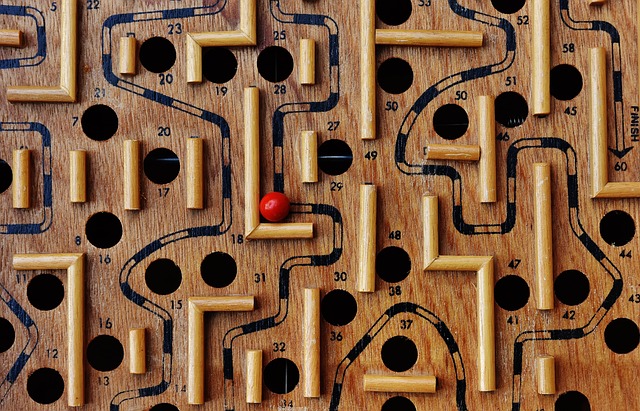
Maze and labyrinth puzzles challenge individuals to find their way from a starting point to a destination, navigating through a complex network of paths or corridors.
Characteristics of Maze Puzzles:
- Branching Paths: Mazes often include multiple paths, some leading to dead ends, requiring problem-solving skills to navigate.
- Single Solution: Usually, there’s only one correct path from entrance to exit.
Labyrinth Puzzles: Differ from mazes in having a single, non-branching path, which leads to the center. Labyrinths are more meditative than mazes, lacking the complexity and stress of wrong turns.
Types of Mazes:
- Rectangular Grid Mazes: The most common type, with vertical and horizontal pathways.
- Circular Mazes: Have rings of pathways centered around a common point, increasing in complexity outwardly.
- 3D Mazes: Extend the challenges to multiple levels, often incorporating gravity or spatial rotation.
Formats:
- Physical Mazes: Found in gardens or cornfields, they provide real-world navigational challenges.
- Print Mazes: Appear in books or magazines for pencil-and-paper solving.
- Digital Mazes: Implemented in video games and apps, they may include interactive elements or time limits.
Children and adults alike enjoy mazes and labyrinths, as they offer engaging ways to develop spatial awareness and problem-solving abilities.









